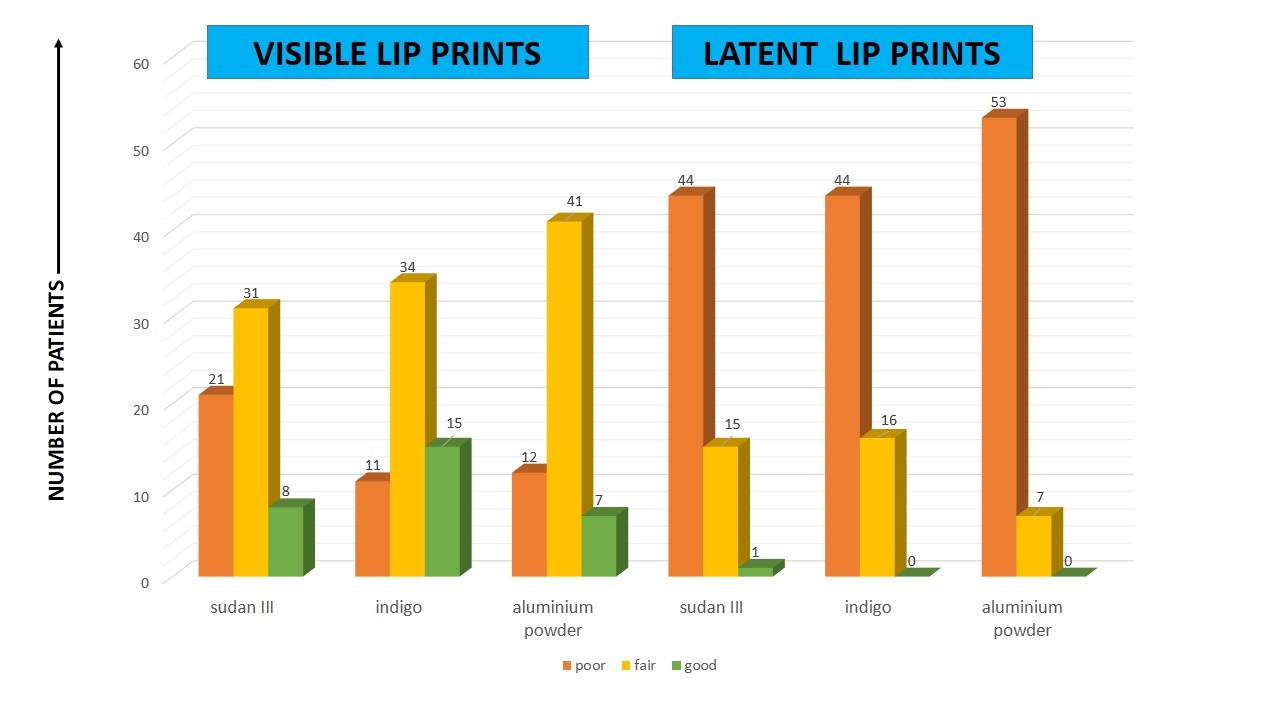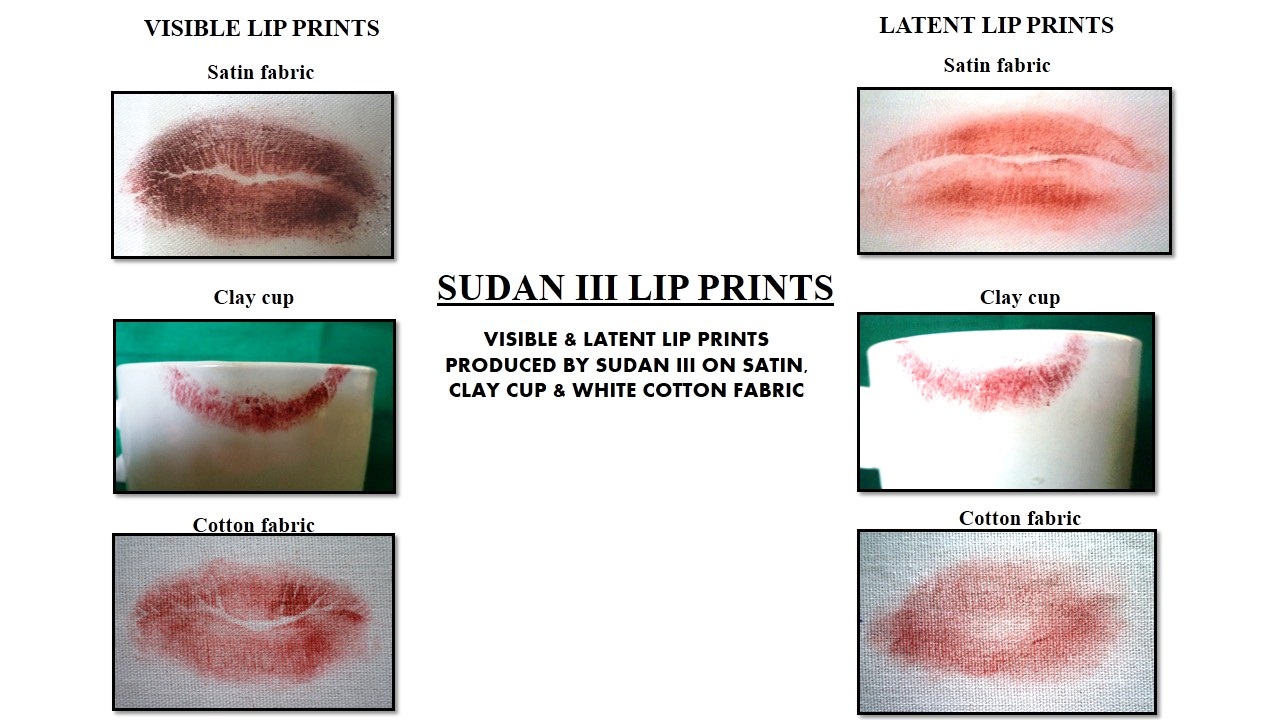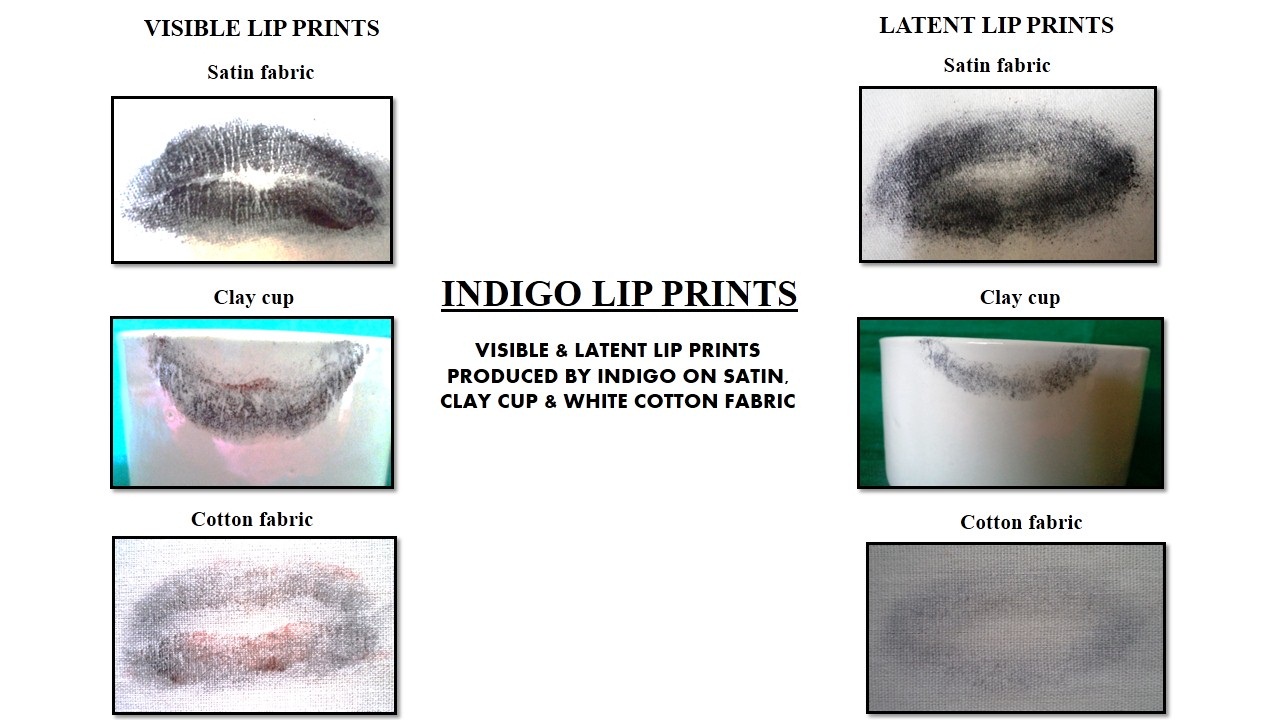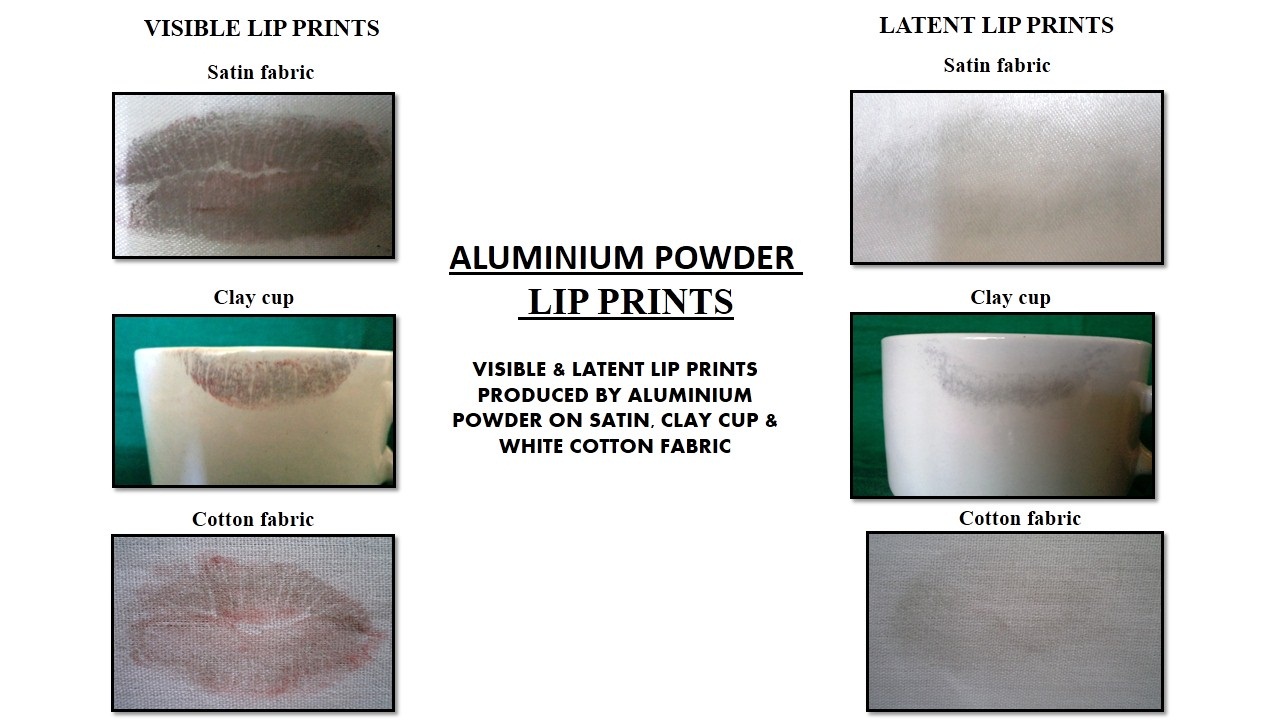The imprint produced by the lip is termed as ‘lip print’ and the name given to the examination of lip print is referred to as cheiloscopy. The word ‘cheiloscopy’ is derived from two Greek words; ‘cheilos’ meaning lip and ‘skopein’ meaning to observe [1].
The lipstick stains present on a suspect’s clothing in a crime scene investigation serves as indirect evidence. This can be used as a link between the suspect and the cosmetic using victim. Similarly, smears can also be found on other objects such as glasses, cups or even cigarette butts and indicate some kind of relation between the suspect and crime scene [2]. Lipsticks are complex substances and they are composed of oils, waxes, organic inks and inorganic pigments for colour. Conventional lipsticks produce a lip print that can be easily identified and are called as visible lip prints, whereas permanent or long lasting lipsticks leave latent prints which are not visible. Latent or visible lip prints could be successfully developed for study purposes using various materials such as aluminium powder, silver metallic powder or cobalt oxide [1].
Indigo dye is naturally derived from the plant of genus ‘Indigofera’ and is native to the tropics [1]. The indigo plant, Indigoferatinctoria which belongs to the family Leguminosae, is mentioned under the name Nila in Sanskrit manuscripts dating back to the 4th century BC. The leaves of indigo plant, which bears red flowers, contains a glucoside, indican.
The generic term used for compounds that have the ability to dye fatty acids is lysochrome. The portion of lysochrome that dissolves in contact with fat is called as lyso and the other portion that is responsible for colour is called as chrome. The various lysochromes are Sudan III, Sudan Black and Oil Red O. The advantage of lysochromes over chemical reagents is that, they have the ability to react with both fats and physical reagents and are highly useful for locating and developing recent as well as older latent lip prints [3].
Thus, the aim of the study was: 1) To compare the efficacy of three different materials used in cheiloscopy – Sudan III (a lysochrome), Indigo (a natural dye) and Aluminium powder (a chemical); 2) To evaluate the efficacy of three different surfaces used for recording lip prints – white clay cup, white cotton fabric, white satin fabric .
Materials and Methods
A prospective study was carried out at MR Ambedkar Dental College & Hospital, Bengaluru, Karnataka, India. Patients and students belonging to the age group of 18 – 25 years were included for obtaining lip prints and study was completed over a period of three months.
Sixty individuals belonging to the age group of 18-25 years were included in the study who were further divided into three groups. Group 1 consisted of lip prints of 20 individuals which were taken on white clay cup, Group 2 consisted of lip prints of 20 individuals, taken on white cotton fabric and Group 3 consisted of lip prints of 20 individuals which were taken on white satin fabric.
The inclusion criteria were, individuals belonging to the age group of 18-25 years, visible and latent prints to be taken from same individual. The exclusion criteria were, individuals having lesions on the lip or with known hypersensitivity to lipsticks, subjects with congenital defects like cleft lip, lip fistula and individuals with prior application of lipstick at the time of taking lip prints were not included in the study.
The materials used were
Lipstick disposable applicator tips,
White clay cup
White cotton fabric
White satin fabric
Camlin S-60 hair brush No. 1
Sudan III dye (NICE Chemicals Private Ltd., Cochin, India)
Indigo blue dye (HiMedia Laboratories Private Ltd., Mumbai, India).
Aluminium metal powder (NICE Chemicals Private Ltd., Cochin, India)
Lip prints were obtained from 60 individuals before and after applying lipstick, with their prior written consent. Lipstick was applied using applicator tips. After one minute of application, lip impressions were made on different aforementioned surfaces using sustained pressure for three seconds. Lip prints were obtained from three groups of 20 individuals each on white cotton fabric, white satin fabric and white clay cup. Six lip prints were taken from each individual i.e., three lip prints prior to applying lipstick which leave latent lip prints and three lip prints after applying lipstick which leave visible lip prints. After obtaining visible and latent lip prints, they were developed instantly without any delay or storage. The three different dyes in powder form were applied on visible as well as latent prints using a camlin hair brush; until the prints became clearly visible. The clarity of the visible and latent lip prints were compared after developing. The grading used is shown in [Table/Fig-1] [1].
Grading of lip prints based on clarity of the grooves.
| Good (++) | Both the outlines of the lip as well as lip grooves are clearly visible |
| Fair (+) | Clearly visible lip outline with less clarity of lip grooves |
| Poor (-) | Outline can be noticed but lip grooves cannot be appreciated |
The results were compared and subjected to statistical analysis. As the study included more than three parameters, chi square test was used.
Results
The visible and latent lip prints of 60 patients using the following dyes were reproduced using three dyes and the no of patients in each group is shown in [Table/Fig-2]. Sudan III dye gave significant results for developing visible lip prints (p< 0.05) using chi square test. A poor result was recorded in white cotton fabric, while higher number of fair result was recorded with white satin fabric. The use of Sudan III for development of latent lip prints did not give any significant results (p= 0.204) [Table/Fig-3,4].
visible and latent Lip prints developed with sudan III black, indigo and aluminium powder

Visible and latent lip prints using sudan III on three different surfaces.
| Fabric Used | Visible Lip PrintsSudan III | Latent Lip PrintsSudan III |
|---|
| POOR | FAIR | GOOD | POOR | FAIR | GOOD |
|---|
| White Cotton Fabric | 13 | 6 | 1 | 18 | 2 | 0 |
| White Satin Fabric | 2 | 15 | 3 | 13 | 7 | 0 |
| White Clay Cup | 6 | 10 | 4 | 13 | 6 | 1 |
| Total | 21 | 31 | 8 | 44 | 15 | 1 |
| χ2 | 14.53 | 5.936 |
| p-value | 0.006* | 0.204 |
The statistical test applied is using chi square test.
*denotes significant association: p-value is significant
Visible and latent lip prints on satin fabric, clay cup and cotton fabric developed with sudan III black.

Indigo dye gave significant results for development of visible lip prints (p<0.05). Satin fabric revealed maximum number of ‘good’ results (n=10) and higher number of ‘fair’ results were obtained with clay cup (n=13).
Indigo dye for developing latent lip prints was found to be statistically significant (p<0.05). The maximum number of ‘fair’ results were obtained on satin fabric (n=9) followed by clay cup (n=6). Higher number of samples yielded a poor result when used with white cotton fabric as well as white clay cup [Table/Fig-5,6].
Visible and latent lip prints using Indigo on three different surfaces.
| Fabric Used | Visible Lip PrintsIndigo | Latent Lip PrintsIndigo |
|---|
| POOR | FAIR | GOOD | POOR | FAIR | GOOD |
|---|
| White Cotton Fabric | 6 | 11 | 13 | 19 | 1 | 0 |
| White Satin Fabric | 0 | 10 | 10 | 11 | 9 | 0 |
| White Clay Cup | 5 | 13 | 2 | 14 | 6 | 1 |
| Total | 11 | 34 | 15 | 44 | 16 | 0 |
| χ2 | 13.648 | 8.352 |
| p-value | 0.009* | 0.015* |
The statistical test applied is using chi square test
*denotes significant association: p-value is significant
Visible and latent lip prints on satin fabric, clay cup and cotton fabric developed with indigo.

Aluminium powder showed significant results when used for the development of visible lip prints (p<0.05). Among the different surfaces used, satin fabric yielded maximum number of ‘fair’ (n=15) and ‘good’ results (n=5). Aluminium powder did not give significant results for the development of latent lip prints (p=0.122) [Table/Fig-7,8].
Visible and latent lip prints using alumnium powder on three different surfaces.
| Fabric Used | Visible Lip PrintsAluminium Powder | Latent Lip PrintsAluminium Powder |
|---|
| POOR | FAIR | GOOD | POOR | FAIR | GOOD |
|---|
| White Cotton Fabric | 4 | 14 | 2 | 20 | 0 | 0 |
| White Satin Fabric | 0 | 15 | 5 | 16 | 4 | 0 |
| White Clay Cup | 8 | 12 | 0 | 17 | 3 | 0 |
| Total | 12 | 41 | 7 | 53 | 7 | 0 |
| χ2 | 13.770 | 4.205 |
| p-value | 0.008* | 0.122 |
The statistical test applied is using chi square test
*denotes significant association: p-value is significant
Visible and latent lip prints on satin fabric, clay cup & cotton fabric developed with aluminium powder.

The comparison of different dyes for the development of latent prints and visible lip prints showed significant association [Table/Fig-9,10]. Similarly, the comparison of different surfaces for the development of lip prints showed significant association [Table/Fig-11].
Table showing comparison of different dyes for the development of latent lip prints.
| Comparison | χ2 | p-value |
|---|
| Sudan III Invisible vs. Indigo Invisible | 15.903 | 0.001* |
| Sudan III Invisible vs. Aluminium Powder Invisible | 9.130 | 0.010* |
| Indigo Invisible vs. Aluminium Powder Invisible | 14.129 | <0.001* |
The statistical test applied is using chi square test
*denotes significant association between the two dye: p values highly significant
Comparisons between different dyes for visible lip prints.
| Comparison | χ2 | p-value |
|---|
| Sudan III Visible vs. Indigo Visible | 8.872 | 0.064 |
| Sudan III Visible vs. Aluminium Powder Visible | 7.088 | 0.131 |
| Indigo Visible vs. Aluminium Powder Visible | 24.511 | <0.001* |
The statistical test applied is using chi square test
*denotes significant association between the two dye: p value highly significant
Table showing comparison of different surfaces for the development of lip prints.
| Comparison | χ2 | p-value |
|---|
| Cotton vs. Satin | 19.226 | 0.001* |
| Cotton vs. Cup | 6.350 | 0.174 |
| Satin vs. Cup | 35.304 | <0.001* |
The statistical test applied is using chi square test
*denotes significant association between the two dye: p values highly significant
Discussion
The most commonly used scientific methods for forensic identification are fingerprints and dental record comparisons [3]. Lip prints have the ability to distinguish individuals and hence, can be used as a potential tool in human identification purposes [4]. The use of lip prints was first recommended as early as in 1932 by Edmond Locard, one of France’s greatest criminologists [5]. They remain the same throughout life and are uninfluenced by environmental changes and diseases [6].
Cheiloscopy deals with the examination of furrows on the red part of human lip and is an important tool in forensic sciences, just similar to fingerprints and DNA analysis [7]. Lip prints are found on various surfaces like glass, clothing, cutlery or cigarette butts. Materials like aluminium and magnetic powder can be used to develop latent or invisible lip prints. The secretions of the sebaceous glands with sweat glands present in between the edges of the lips enable development of latent lip prints [8].
In 1950, Le Moyne Snyder suggested the idea of using lip print for a detailed investigation of the measurement of lips, the use and the colour of rouge and the method of its extraction to obtain useful data for forensic application was made by Suzuki in 1967 [9]. Mac Donnell reported that two identical twins who were indisting-uishable by other means had different lip prints [10]. Based on lip prints, the mucosal area of the individual lips is pivotal as far as identification is considered and this area is called as Klein’s zone. This zone is covered with grooves and wrinkles which form a characteristic pattern called as lip print, which are permanent and unchangeable like fingerprint and palatal rugae [11].
Old fashioned lip stick produces lip print that is easily distinguishable compared to lip prints made without lipstick which are invisible called as latent lip prints. Development of latent lip prints entails usage of reagents that are more sensitive than conventional materials to locate and develop the invisible prints [12]. The usage of latent lip prints is more limiting due to the fact that the data of lip prints do not exist, but this type of evidence could be substantiated for identification, if it is possible to compare the latent lip print with the lip print of the suspect [13].
Lip stick contains several constituents like solid base of waxes, oils, dissolved dyes, hydrocarbons and perfumes. Minimum quantities of fatty substances are present in long lasting lipsticks, thus development of lip prints using conventional powders might not be very effective. The humidity present in lips as well as the saliva, mixed with the oiliness secreted by neighbouring salivary and sebaceous glands results in the formation of latent or invisible lip prints. These lipids and fatty acids transferred to an object through lip contact and can be developed and made visible. Therefore, latent lip prints can be better developed by using materials that are more sensitive to fatty acids. Lysochromes contain a portion that dissolves in contact with the fat and another that stains and hence, have the ability to stain fatty acids. Due to the same reason lysochromes are more sensitive when it comes to developing latent lip prints [14].
Obtaining lip prints is highly technique sensitive as it depends on various factors like the amount of pressure applied, direction and method used in making the print as well as the amount of lipstick used for developing lip prints [15]. Collection of the lip prints with a suitable transferring and recording media is important.
Developers are substances used for developing visible and latent lip prints. They are useful for different kinds of surfaces (both porous and non-porous) as well as those which are more efficient in case of old or recent prints, have been described. It is possible to obtain DNA profiles from a latent lip print developed using lysochromes dyes [16]. Lip prints left at crime scene help in identification of suspect when proper comparison is done [17].
The present study shows that Indigo dye was the best which showed both significant visible and latent lip prints on white satin fabric. While both Sudan III and Aluminium powder showed only significant visible lip prints on white satin fabric. The proportion of lip prints graded as ‘good’ and ‘fair’ were more for Indigo dye, whereas poor grading were seen for both Sudan III and Aluminium powder. Similar findings were observed by Singh et al., [1].
Satin fabric and cup yielded better results as compared to cotton fabric, probably due to greater absorbance of lipstick content by the cotton. The smoother and uniform surface of white clay cup and satin fabric are better for the development of lip prints than cotton fabric. Visible lip prints can be better developed as compared to latent prints because of their high oil content and hence, they absorb the chemical reagent better [1].
A similar study conducted by Singh N N et al., using Vermilion, Sudan black and Indigo dye showed statistically significant difference between Sudan black and Vermilion only. Cup was found to have significantly higher good lip prints developed as compared to both satin and cotton, while satin was found to have significantly higher good lip prints developed as compared to cotton [1].
A study was conducted by Kumar P et al., in 2010 on the comp-arison of fluorescent and lysochrome dyes in developing invisible lip prints. Fluorescent dyes gave better results than lysochrome dyes. Of the 200 samples, all showed positive development with fluorescent and lysochrome dye and the lip patterns were well appreciated in fluorescent dyes [18].
A study by Castello A et al., showed that lysochromes are very effective when used on long-lasting lipstick prints on porous surfaces, such as paper or fabric, where detection is usually difficult. This study documented that lysochromes are a highly useful group of compounds for locating and developing recent as well as older latent lip prints [19].
Another study on the effectiveness of lysochromes on developing lip marks on human skin showed that dyes like Sudan III, Sudan black and Oil Red O are effective for obtaining recent latent lip prints on human skin. A positive development was obtained for all the lip prints studied. The shape and lip outline were perfectly developed and also the lip grooves and wrinkles were also seen [20].
Studies were conducted on development of old latent lip prints using aluminium powder, cobalt oxide powder and magnetic powder. The results were highly favourable both for the prints that were developed on ceramics and on glass. Nevertheless development on paper was only possible up to 24 hours after taking the lip impression. No development was possible using fabric. Cobalt oxide powder presented worse results than aluminium powder, as only in the case of white ceramics where any favourable results obtained over longer periods of time. In this case, no prints were obtained on paper or fabric. The results obtained using magnetic powder as a developer offered no differences from those obtained using aluminum powder. No latent prints were found on fabric when this material was used as a developer [21].
Latent lip prints might play a key role in identification of crime scene investigations. A group of Spanish investigators in their study revealed that latent lip prints could be investigated in a similar way to fingerprinting, using similar techniques. In fact, latent prints can be easily seen using fluorescent dyes even when located on “difficult” surfaces (such as porous or multi-coloured ones). Latent lip prints are very helpful when processing a crime scene, even if there are no traces of lipstick. Individual photographs of latent lip prints along with identification label and scale must be taken [22].
Developments in the sensitivity of methods used to examine latent prints (finger or labial) make it essential to find more effective ways of locating prints on different surfaces. The most challenging surfaces are those which are either porous or multi-coloured where the developed print may not be easily seen [23].
A major shortcoming of lip print analysis is regarding the per-manence of various lip print patterns. Even though they are believed to remain unchanged throughout one’s life, various studies have cautioned that major trauma to the lips can result in scarring. Also, surgical treatments carried out to correct any abnormality can affect the size and shape of lips and alter the morphology and pattern of lip grooves [24].
The lip prints produced may vary in appearance as the lip grooves and fissures are present on the mobile zone. Hence, this field requires further study to comprehensively establish the uniqueness of lip grooves, to develop standard protocols for collecting and analyzing lip prints [24].
Lip print left at crime scenes can provide a direct link between the suspect and the crime scene. The vermilion border of the lips together with an individual structure of lines may constitute a source of circumstantial evidence. Cheiloscopy is applicable mostly in identifying the living, since lip prints are usually left at crime scenes and can provide a direct link to the suspect [24].
Future Perspectives: Though lip prints are sole to an individual like fingerprints, advance studies are needed to address the uniqueness of lip grooves and also human characteristics like crusting of lips, post-surgical scars and pathologies like congenital lip pits, clefts, mucocele, ulceration, chelitis granulomatosa, etc., [25]. The future of lip print analysis depends on various factors like establishing the permanence and uniqueness of lip prints and development of standard protocols for obtaining and developing lip prints.
Limitation
The present study does not include the use of fluorescent dyes. Fluorescent dyes are more suitable for development of lip prints on multicolored surfaces. In this study only white colour is used as it is better to develop prints on white background for study purposes. In a crime scene investigation, lip prints might be found on coloured surfaces. Hence, further extensive studies are required for obtaining standardized techniques for development of lip prints.
Conclusion
Lip print analysis is a very simple and inexpensive procedure. Hence, it may be suggested that the lip prints could be used as a reliable aid to human identification in the field of forensic disciplines. The use of lip prints exist as evidence in personal identification and criminal investigation in forensic dentistry; but research studies and information are very much scanty regarding the various techniques used for obtaining lip prints and its permanence.
The statistical test applied is using chi square test.*denotes significant association: p-value is significantThe statistical test applied is using chi square test*denotes significant association: p-value is significantThe statistical test applied is using chi square test*denotes significant association: p-value is significantThe statistical test applied is using chi square test*denotes significant association between the two dye: p values highly significantThe statistical test applied is using chi square test*denotes significant association between the two dye: p value highly significantThe statistical test applied is using chi square test*denotes significant association between the two dye: p values highly significant